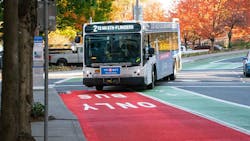Faster buses helps TriMet ease congestion, provide a better ride throughout the region
As congestion levels begin to increase following stay-at-home orders due to the pandemic, TriMet says it will continue to work with regional partners to find ways to keep buses and riders moving through traffic.
The fixes are simple and include small changes that make a big difference. The added benefit is that many of the improvements also help keep autos moving. As a result, there are fewer traffic delays, faster trips and safer roads for everyone.
Fast, low-cost changes
An extended turn lane, a signal adjustment or a new turn signal – these are the types of small changes the Portland Bureau of Transportation (PBOT) is making to help get buses moving past traffic and keep everyone moving.
The latest improvement was made as part of a paving project in northeast Portland. When crews put new striping at the intersection of Northeast 57th and Sandy, they extended the left turn lanes. By creating more space for cars to line up, it will be easier for buses to get through the light. The minor adjustment is expected to speed up trips on Line 71-60th Ave and help improve general traffic flow.
When PBOT installed left turn lanes at North Albina and Rosa Parks Way, as well as Albina and Alberta streets, delays on Line 4-Fessenden fell by nearly a quarter during the evening rush. Delays dropped by as much as 30 percent on Line 77-Broadway/Halsey after PBOT put in a left turn signal at Northwest 21st and Everett earlier this year, which also improved safety for auto drivers making turns at the intersection.
Red marks the spot
Last fall, Portland joined a handful of U.S. cities to take part in a pilot project that uses red paint to draw attention to transit priority lanes. Now, the first such lanes have also been painted in Washington County, at the intersection of NW 185th Avenue and Cornell Boulevard. While the lanes speed up buses by keeping them clear of cars, they also bring a safety benefit to auto drivers, by helping to clarify rules of the road in an increasingly cluttered and distracted environment.
Speeding up buses
Dedicated transit travel lanes are also helping to speed up buses and riders heading out of downtown Portland to destinations across the metro area. Last fall, PBOT removed parking for city vehicles on Southwest Madison Street to make room for a new bus and bike only lane between 1st and 4th Avenues. The lane was extended to 5th Avenue over the summer. The new lane speeds up buses on five TriMet lines, decreasing delays by as much as 76 percent. PBOT retained space for two existing travel lanes for automobile traffic approaching the Hawthorne Bridge.
One foot goes the mile
TriMet says these projects, designed to speed up transit, frequently involve improvements as simple as restriping pavement. In southeast Portland, at Southeast 60th and Division, buses were getting delayed behind vehicles that slowed or stopped to make left turns. PBOT looked at the size of the lanes. By restriping the lanes and expanding the through lane by just one foot, it gave buses and other vehicles space to pass those waiting in the turn lane. The move decreased delays on Line 2-Division buses by nearly 23 percent during the evening rush.
Turning a corner with new turn lanes
Another small striping project helped speed up traffic in northeast Portland. Buses and automobiles were getting stuck behind vehicles making turns at Northeast 15th Avenue and Fremont Street. To help keep traffic moving, PBOT added left turn lanes in all four directions of the intersection. After the improvement, bus delays on Line 8-Jackson Park/NE 15th and Line 24-Fremont decreased by as much as 48 percent, and all drivers through the area saw shorter waits at the light.
Making transit better
These are just a few of the projects implemented by TriMet partners to make transit better and help the transportation system work for everyone. When trips on buses and trains are safe, fast and reliable, TriMet says transit becomes a more viable option for getting to work, school, appointments and events.
